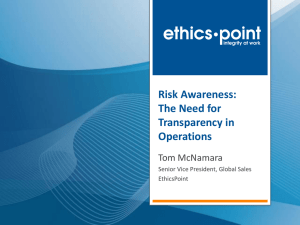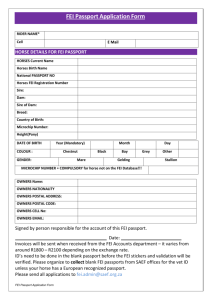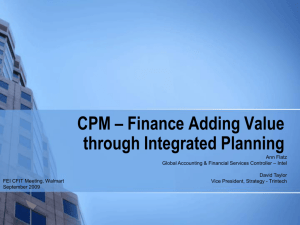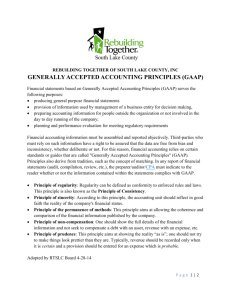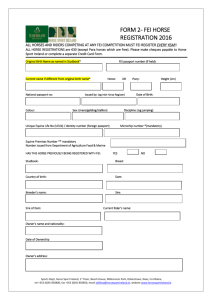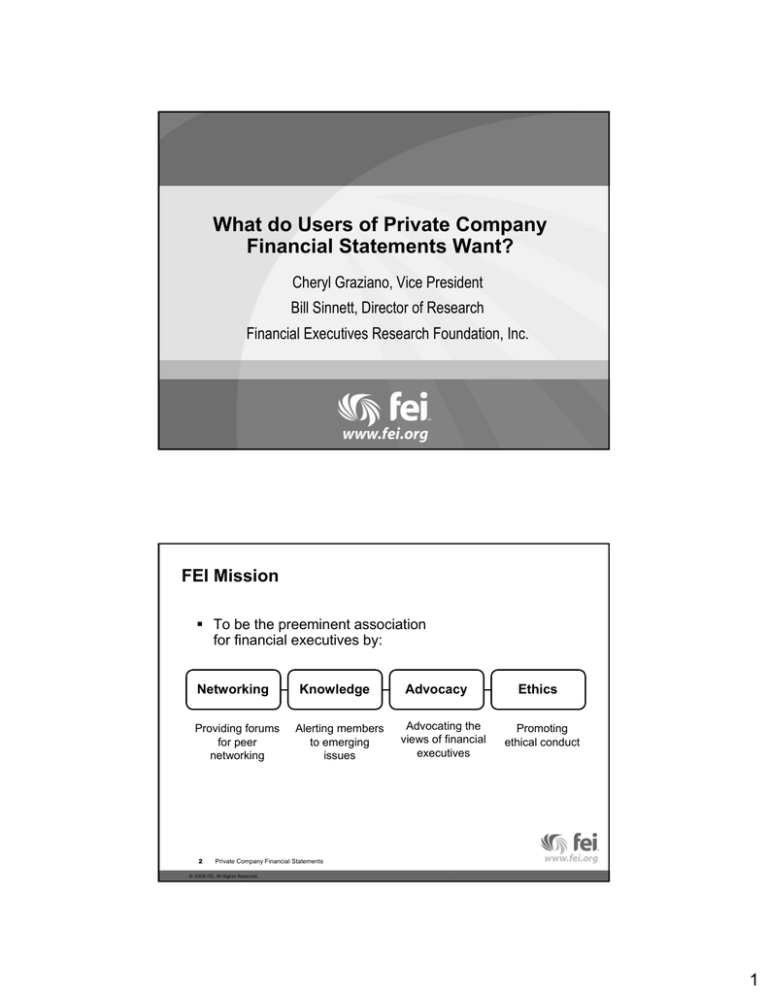
What do Users of Private Company
Financial Statements Want?
Cheryl Graziano, Vice President
Bill Sinnett, Director of Research
Financial Executives Research Foundation, Inc.
FEI Mission
To be the preeminent association
for financial executives by:
Networking
Providing forums
for peer
networking
2
Knowledge
Alerting members
to emerging
issues
Advocacy
Advocating the
views of financial
executives
Ethics
Promoting
ethical conduct
Private Company Financial Statements
© 2006 FEI. All Rights Reserved.
1
FEI provides its members with:
KNOWLEDGE: saving financial executives time
and helping them work smarter
– Emerging issues, market trends, regulatory and legislative updates
– Practical research, benchmarking and case studies from Financial
Executives Research Foundation (FERF)
– Professional development, both online and in-person
– Valuable career management tools
– One-stop Web site offering virtual benefits: technical articles,
committee interpretations, conference presentations, CPE center, daily
issues updates
– Financial Executive: our award-winning magazine
– FEI Express, weekly newsletter
– Ask FERF online research service
3
Private Company Financial Statements
© 2006 FEI. All Rights Reserved.
FEI provides its members with:
ADVOCACY: speaking for the interests of corporate
finance
– A widely-respected voice for corporate finance issues
– Representing our members’ interests before the SEC,
FASB, PCAOB, IASB, Congress, COSO
– Demonstrated legislative and regulatory impact
ETHICAL LEADERSHIP: raising the bar for the
profession
– FEI’s code of ethics is an industry model
– Dedicated to advancing ethical, responsible financial
management
– Helping our members build their leadership skills
4
Private Company Financial Statements
© 2006 FEI. All Rights Reserved.
2
Financial Executives
Research Foundation (FERF)
Independent non-profit research affiliate of FEI
Mission: to advance the profession and practices of
financial management through research
Facilitate learning from other financial executives
through:
– Research publications and alerts
– Research services
– Interactive forum for peers (FELIX)
– Distance learning with CPE
Supported by voluntary, tax-deductible contributions
and from corporations, FEI chapters and individuals
5
Private Company Financial Statements
© 2006 FEI. All Rights Reserved.
CPE Center at www. fei.org
One-stop management of individual’s
CPA license renewal
– Ability to track all FEI and non FEI events
– Tracks fields of study, stores certificates and much more
Earn CPE credits for reading Financial Executive
magazine
– 2 credits per issue
Earn CPE credits for reading FERF reports
6
Private Company Financial Statements
© 2006 FEI. All Rights Reserved.
3
What do Users of Private Company Financial
Statements Want?
Research project was sponsored by the National
Federation of Independent Business (NFIB)
FERF staff worked with FEI’s Committee on Private
Companies (CPC) to develop interview questions
FERF staff interviewed preparers, commercial bankers,
and investment bankers
One preparer and four commercial bankers completed
survey questionnaire in lieu of interview
FERF staff drafted report
NFIB, CPC and FERF Research Advisory Council
reviewed draft report
7
Private Company Financial Statements
© 2006 FEI. All Rights Reserved.
Today’s Agenda
What About Your Company?
Research Interviews
Research Themes
Next Steps
8
Private Company Financial Statements
© 2006 FEI. All Rights Reserved.
4
What About Your Company?
Your role
Who uses your financial statements?
What information do they require?
What other information should be provided?
9
Private Company Financial Statements
© 2006 FEI. All Rights Reserved.
Research Interviews
Seven preparers of financial statements
– 1 completed a survey
Nine commercial bankers
– 4 completed a survey via American Bankers Association
Two investment bankers
10
Private Company Financial Statements
© 2006 FEI. All Rights Reserved.
5
Preparers
A: Small medical device manufacturer
B: Mid-size high-tech manufacturer
C: Mid-size health care provider
D: Small retailer
E: Mid-size mining company
F: Small manufacturer
G: Mid-size restaurant chain
11
Private Company Financial Statements
© 2006 FEI. All Rights Reserved.
Company A: Small Medical Device
Manufacturer
Owned by 300 physicians and a venture capital firm
We send out a stockholder letter every two months.
The most important metric is the timetable to
commercialization (how long to revenue)
We provide financial statements to anyone who
provides capital and anyone doing due diligence
We prepare GAAP statements, but we have problems
accounting for options and warrants
I have issues with Sarbanes-Oxley, and I support the
recommendations of the SEC Advisory Committee that
smaller companies be exempted
12
Private Company Financial Statements
© 2006 FEI. All Rights Reserved.
6
Company B: Mid-Size High-Tech Manufacturer
Owned by LLC that is multi-generational trust
Good cash flow is our main objective
Financial statements go to management and owners
four days after month end
Incentive plans are based on financial statements
I don’t like the idea of two sets of GAAP
But I do like different footnotes for private than for public
companies
13
Private Company Financial Statements
© 2006 FEI. All Rights Reserved.
Company C: Mid-Size Health Care Provider
Owner entirely by the employees
3 employees own a controlling share of the company
Monthly financial statements (modified cash reports)
sent to each profit center
Quarterly financial statements sent to board, banks, and
investment banker
Annual financial statements have exceptions to GAAP:
– FSP 150: Mandatorily Redeemable Shares
– FIN 46: Consolidation of Variable Interest Entities
– FAS 133: Accounting for Derivatives
14
Private Company Financial Statements
© 2006 FEI. All Rights Reserved.
7
Company D: Small Retailer
97% family owned
GAAP not necessary for internal management financial
statements
Internal financial statements adjusted for external users
Only debt is a credit revolver with a bank syndicate
Banks require annual audited GAAP financial
statements
If we want to open a new store, the new landlord may
ask for GAAP financial statements
15
Private Company Financial Statements
© 2006 FEI. All Rights Reserved.
Company E: Mid-Size Mining Company
46.5% owned by CEO, 46.5% owned by outside
investor group, and 7% owned by others
Financial statements are only a portion of our
communication with investors, bankers, and others
The CEO and the outside investors want monthly
operational data
Banks want quarterly measures of liquidity, as specified
in debt covenants
Insurance companies are satisfied with annual audited
GAAP financial statements
16
Private Company Financial Statements
© 2006 FEI. All Rights Reserved.
8
Company F: Small Manufacturer
Three owners, including CFO who was interviewed
Bank wants annual audited GAAP financial statements
Banks also want:
– Detailed aged payables, receivables and inventory
– Monthly loan covenant calculations
– Collateral reports
– Quarterly cash flow coverage
Banks use financial information to calculate loan ratios
Vendors want financial statements, but we give an
Altman Z score instead
17
Private Company Financial Statements
© 2006 FEI. All Rights Reserved.
Company G: Mid-Size Restaurant Chain
Privately owned by stockholders, with no plans to go
public
Most important financial information is internal financial
reports used to run the business
Banks want annual audited GAAP financial statements
for consistency and accuracy
Banks focus on cash flow, and ignore non-cash items
and “funny money” items, like minimum pension
liabilities, that have no effect on cash flow
We use GAAP financial statements to compare our
company with other companies in our industry
18
Private Company Financial Statements
© 2006 FEI. All Rights Reserved.
9
Commercial Bankers
A: Small Southeast regional bank
B: Large NYC money center bank
C: Small Midwest regional bank
D: Large Southeast regional bank
E: Large international bank
F: Small bank based in New Mexico
G: Small bank based in Virginia
H: Small bank based in North Carolina
I: Small bank based in Wisconsin
19
Private Company Financial Statements
© 2006 FEI. All Rights Reserved.
Bank A: Small Southeast Regional Bank
Virtually all commercial customers are privates
Bank policy requires:
– Audited GAAP financial statements for credit exposures of $3 million or
more
– Audit reviews for credit exposures less than $3 million
– We can make exceptions for long-term customers with strong financial
performance
We look for liquidity, which can be determined from the
balance sheet or the cash flow statement
We often use income tax returns to confirm certain
information not available from GAAP statements alone
20
Private Company Financial Statements
© 2006 FEI. All Rights Reserved.
10
Bank B: Large NYC Money Center Bank
Baseline financial statement requirements are specified
in the original loan proposal:
– Annual audited GAAP financial statements
– Quarterly financial statements without footnotes
– Monthly financial statements, with aged receivables and payables
We get the same information from private companies as
we do from public companies
We will make exceptions for GAAP accounting for noncash items if we can measure cash flow
We like borrowers to use auditors who we know
We consider GAAP financial statements to be a
standard management tool already being used
21
Private Company Financial Statements
© 2006 FEI. All Rights Reserved.
Bank C: Small Midwest Regional Bank
A full set of GAAP financial statements are required,
including footnotes
GAAP financial statements provide uniformity for more
accurate historic and industry comparisons
The financial strength of the debtor is a driving factor for
how frequently we require financial information
At a minimum, annual audited GAAP financial
statements are required
Higher risk borrowers are required to provide more
frequent financial information
22
Private Company Financial Statements
© 2006 FEI. All Rights Reserved.
11
Bank D: Large Southeast Regional Bank
We need good financial statements for proper cash flow
analysis
Audited financial statements provide more credible
financial information, so an audit is better than a review
GAAP provides consistency
We require audited financial statements for loan
balances over $5 million, but we do make exceptions
We do not require audited financial statements for loan
balances under $300K
For smaller loans, key financial information and
individual credit scores are reviewed
23
Private Company Financial Statements
© 2006 FEI. All Rights Reserved.
Bank E: Large International Bank
The most important thing to the lender is cash flow
Financial information, in order of importance:
– The cash flow statement, income statement, and EBITDA will help you
determine whether you will get paid back
– The balance sheet will show existing obligations
– The balance sheet will also show the hard asset base, which will
provide security if the borrower is non-investment grade
We require an MD&A, either on a monthly or quarterly
basis, depending on the company
MD&A is always valuable, because it explains why
management does certain things, and it explains
changes in income and expense accounts
24
Private Company Financial Statements
© 2006 FEI. All Rights Reserved.
12
Bank F: Small Bank Based in New Mexico
Financial statements are needed to monitor ongoing
trends
For small companies, we will accept self-prepared
financials
We require specific financial information relevant to the
credit being granted
We don’t ask for what we don’t need
For most loans, financials are only required annually
For more complex or risky situations, financials could be
required quarterly or even monthly
25
Private Company Financial Statements
© 2006 FEI. All Rights Reserved.
Bank G: Small Bank Based in Virginia
Loan agreements generally require a company to
provide annually a balance sheet, an income statement,
and a statement of cash flows as of the fiscal year end
If financial statements are not audited, we will verify the
income statement against the company’s federal tax
return, prepared by a CPA
If a company is closely held, we also require copies of
personal financial statements and individual tax returns
However, we have more confidence in financial
statements prepared by a CPA according to GAAP
26
Private Company Financial Statements
© 2006 FEI. All Rights Reserved.
13
Bank H: Small Bank Based in North Carolina
Size of total loan relationship is our determining factor
as to the sophistication of the financial statements
required
We typically ask for:
– Lists of assets and liabilities
– Profit and loss statements
– Cash flow statements, and
– Tax returns and other proof of income
Both GAAP financial statements and Federal tax returns
are important for our decision-making
27
Private Company Financial Statements
© 2006 FEI. All Rights Reserved.
Bank I: Small Bank Based in Wisconsin
Most of our clients are privately held companies
With a few exceptions, our clients do not have internal
audit procedures or externally audited statements
We look at financial statements to determine a
company’s:
– Viability, as it relates to current net worth
– Ability to generate future earnings
– Asset base
– Cash flow and future cash flow
– Obligations to others
28
Private Company Financial Statements
© 2006 FEI. All Rights Reserved.
14
Investment Bankers
A: Small Midwest regional investment bank
B: Small Southwest regional investment bank
29
Private Company Financial Statements
© 2006 FEI. All Rights Reserved.
Investment Banker A: Small Midwest Regional
We need and rely on audited GAAP financial
statements
We also look for supplemental information
We are primarily interested in equity vs. debt
Buyers are interested in capital expenditure
requirements, which you cannot get from statements
Many buyers pay on EBITDA less cap ex
GAAP provides security
Fair value is important if the company is not liquid
Fair value is important for weak companies
30
Private Company Financial Statements
© 2006 FEI. All Rights Reserved.
15
Investment Banker B: Small Southeast
Regional Investment Bank
GAAP is not always logical, but
We prefer GAAP financial statements for accuracy and
consistency
We look at private companies in the same way as public
companies
We request supplemental schedules, because GAAP
does not provide detailed information on revenues and
expenses
Compliance with Sarbanes-Oxley will make transaction
closing easier
31
Private Company Financial Statements
© 2006 FEI. All Rights Reserved.
Research Themes
Themes by User
Use of GAAP
Debt Covenants
Internal Controls
32
Private Company Financial Statements
© 2006 FEI. All Rights Reserved.
16
Users
Internal Management
Commercial Bankers
Investment Bankers
Investors
33
Private Company Financial Statements
© 2006 FEI. All Rights Reserved.
Internal Management
Internal managers receive financial and operating
information for their businesses
Financial information is NOT in format of GAAP fulldisclosure financial statements
Operating information is provided weekly and monthly
34
Private Company Financial Statements
© 2006 FEI. All Rights Reserved.
17
Commercial Bankers
Banks want annual audited GAAP financial statements
for accuracy and comparability
Banks want quarterly financial statements
Other financial information that may be requested:
– Detailed aged payables, receivables and inventory
– Monthly loan covenant calculations
– Collateral reports
– Quarterly cash flow coverage information
Financial statement data is entered into computer
models and databases to monitory compliance with
debt covenants
35
Private Company Financial Statements
© 2006 FEI. All Rights Reserved.
Investment Bankers
Investment bankers only use financial statements of
clients and potential clients, companies looking for a
liquidity event
Want audited annual GAAP financial statements for
accuracy and comparability
Want supplemental information beyond GAAP, such as
history of capital expenditures
A Fair Value appraisal will be required if the company is
not liquid
36
Private Company Financial Statements
© 2006 FEI. All Rights Reserved.
18
Investors
Want more information than is provided by GAAP
financial statements
Are often more interested in operating data than
financial data
Consider trend lines and year-over-year comparisons to
be important
37
Private Company Financial Statements
© 2006 FEI. All Rights Reserved.
Use of GAAP
GAAP does not provide the detail needed by investors
or even banks
Certain calculations are difficult and time consuming
– FIN 46
38
Private Company Financial Statements
© 2006 FEI. All Rights Reserved.
19
Debt Covenants
Not always standardized, and often based on the borrower’s
industry
Financial information required includes:
– EDITDA and Cash flow
– Tangible net worth (exclude intangibles such as goodwill)
EBITDA is a proxy for cash earnings, and is very important to
banks
– Segregate depreciation and amortization, so they can be added back
Debt covenants may require maintaining ratios such as:
– Leverage: Liabilities/Net Worth < 3:1
– Earnings: Debt/EBITDA < 3:1
39
Private Company Financial Statements
© 2006 FEI. All Rights Reserved.
Internal Controls
The ONLY users requesting compliance with SarbanesOxley are investment bankers, in anticipation of sale or
IPO
40
Private Company Financial Statements
© 2006 FEI. All Rights Reserved.
20
Questions?
?
?
41
Private Company Financial Statements
© 2006 FEI. All Rights Reserved.
Next Steps
Suggestions for follow research on this project?
Suggestions for other types of research projects?
42
Private Company Financial Statements
© 2006 FEI. All Rights Reserved.
21
Stay in Touch
Cheryl Graziano
Vice President, Research and Operations
FERF
(973) 765-1064
cgraziano@fei.org
43
Private Company Financial Statements
© 2006 FEI. All Rights Reserved.
Stay in Touch
Bill Sinnett
Director of Research
FERF
(973) 765-1004
bsinnett@fei.org
44
Private Company Financial Statements
© 2006 FEI. All Rights Reserved.
22


